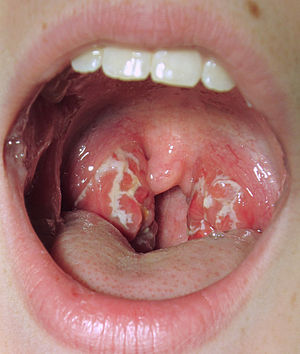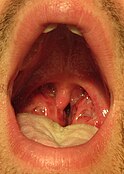연쇄상구균 인두염: 두 판 사이의 차이
| 48번째 줄: | 48번째 줄: | ||
== 예방 == |
== 예방 == |
||
목구멍에 감염이 잦은 사람들에게는 (1년에 세 차례 이상) [[편도절제술]]이 합리적인 예방책이 될 수 있다.<ref>{{cite journal |vauthors=Johnson BC, Alvi A | title = Cost-effective workup for tonsillitis. Testing, treatment, and potential complications | journal = Postgrad Med | volume = 113 | issue = 3 | pages = 115–8, 121 |date=March 2003 | pmid = 12647478 | doi = 10.3810/pgm.2003.03.1391| s2cid = 33329630 }}</ref> 그러나 그 이득은 적으며 감염도 조치를 취했는지와 관계없이 시간이 지날수록 적게 나타나는 게 일반적이다.<ref>{{cite journal|vauthors=van Staaij BK, van den Akker EH, van der Heijden GJ, Schilder AG, Hoes AW |title=Adenotonsillectomy for upper respiratory infections: evidence based?|journal=Archives of Disease in Childhood|date=January 2005|volume=90|issue=1|pages=19–25|pmid=15613505|doi=10.1136/adc.2003.047530|pmc=1720065}}</ref><ref>{{cite journal|last1=Burton|first1=MJ|last2=Glasziou|first2=PP|last3=Chong|first3=LY|last4=Venekamp|first4=RP|title=Tonsillectomy or adenotonsillectomy versus non-surgical treatment for chronic/recurrent acute tonsillitis.|journal=The Cochrane Database of Systematic Reviews|date=19 November 2014|issue=11|pages=CD001802|pmid=25407135|doi=10.1002/14651858.CD001802.pub3|pmc=7075105|url=https://pure.bond.edu.au/ws/files/32844113/Tonsillectomy_or_adenotonsillectomy_versus_non_surgical_treatment_for_chronic.pdf}}</ref><ref>{{cite journal|last1=Morad|first1=Anna|last2=Sathe|first2=Nila A.|last3=Francis|first3=David O.|last4=McPheeters|first4=Melissa L.|last5=Chinnadurai|first5=Sivakumar|title=Tonsillectomy Versus Watchful Waiting for Recurrent Throat Infection: A Systematic Review|journal=Pediatrics|date=17 January 2017|pages=e20163490|doi=10.1542/peds.2016-3490|url= http://pediatrics.aappublications.org/content/early/2017/01/15/peds.2016-3490?sso=1&sso_redirect_count=1&nfstatus=401&nftoken=00000000-0000-0000-0000-000000000000&nfstatusdescription=ERROR%3A+No+local+token|language=en|issn=0031-4005|volume=139|issue=2|pmid=28096515|pmc=5260157|url-status=live|archive-url=https://web.archive.org/web/20170813012822/http://pediatrics.aappublications.org/content/early/2017/01/15/peds.2016-3490?sso=1&sso_redirect_count=1&nfstatus=401&nftoken=00000000-0000-0000-0000-000000000000&nfstatusdescription=ERROR%3A+No+local+token|archive-date=13 August 2017}}</ref> 화농성연쇄상구균 검사 양성이며 인두염이 재발하는 경우에는 재발성 바이러스 감염에 걸린 화농성연쇄상구균의 만성 보균자일 수 있다.<ref name=IDSA2012/> 균에 노출되었지만 증상을 보이지 않는 사람에 대한 치료는 권장되지 않는다.<ref name=IDSA2012/> 화농성연쇄상구균 보균자를 치료하는 것 역시 전파와 합병증의 위험성이 적기 때문에 권장되지 않는다.<ref name=IDSA2012/> |
|||
목구멍에 감염이 잦은 사람들에게는 (1년에 세 차례 이상) [[편도선 수술]]이 합리적인 예방책이다.<ref>{{저널 인용 | author = Johnson BC, Alvi A | 제목 = Cost-effective workup for tonsillitis. Testing, treatment, and potential complications | journal = Postgrad Med | volume = 113 | issue = 3 | pages = 115–8, 121 |date=March 2003 | pmid = 12647478 | doi = 10.3810/pgm.2003.03.1391}}</ref> |
|||
== 각주 == |
== 각주 == |
||
2022년 8월 11일 (목) 22:05 판
 Streptococcal pharyngitis | |
|---|---|
 | |
| 16세 아이에게 발병한 연쇄상구균 인두염의 모습. 인두의 삼출물이 보인다. | |
| 진료과 | 감염내과 |
| 증상 | 발열, 인후통, 림프절 부음[1] |
| 통상적 발병 시기 | 노출 이후 1 ~ 3일 후[2][3] |
| 기간 | 7 ~ 10일[2][3] |
| 병인 | A군 연쇄상구균[1] |
| 위험 인자 | 음료나 주방 기구를 같이 사용[4] |
| 진단 방식 | 인후배양, 신속 연쇄상구균 검사[1] |
| 유사 질병 | 후두덮개염, 감염성 단핵구증, 구강저 봉와직염, 편도주위농양, 인두후농양, 바이러스성 인후염[5] |
| 예방 | 손 씻기,[1] 기침 막기[4] |
| 치료 | 파라세타몰, NSAID, 항생제[1][6] |
| 빈도 | 전체 인후통의 5 ~ 40%[7][8] |
연쇄상구균 인두염(連鎭狀球菌咽頭炎, streptococcal pharyngitis, streptococcal tonsillitis, streptococcal sore throat, strep throat , strep)은 A군 연쇄상구균에 감염되어 발병하는 인두염이다.[1] 잘 나타나는 증상에는 발열, 인후통, 편도염, 목의 림프절 붓기 등이 있다. 두통이나 구역질, 구토를 동반하기도 한다.[1] 성홍열이라고 하는 사포나 닭살과 비슷하게 생긴 발진이 나타나는 환자도 있다.[2] 일반적으로 병원균에 노출된 후 1 ~ 3일 정도에 증상이 나타나며 증상은 7 ~ 10일 정도 지속된다.[2][3]
감염된 사람에서 나온 호흡기 비말에 의해 전파된다.[1] 비말은 직접 다른 사람한테 옮겨 가거나 비말이 묻은 무언가를 다른 사람이 만진 뒤에 입, 코, 눈에 갖다 대면서 전파될 수 있다.[1] 무증상 감염이 일어나기도 한다.[1] 또한 A군 연쇄상구균에 감염된 피부를 통해 전파될 수도 있다.[1] 진단은 증상을 가진 사람들에서 신속항원검사나 인후배양을 거친 결과를 기반으로 내린다.[9]
손 씻기나 주방 기구를 같이 쓰지 않는 방법으로 연쇄상구균 감염을 예방할 수 있다.[1] 효과적인 백신은 존재하지 않는다.[1] 항생제 치료는 확진 판정을 받은 사람들에게만 권장된다.[9] 감염된 환자는 발열이 사라질 때까지, 그리고 치료를 시작한 지 최소 12시간이 지날 때까지는 다른 사람들과의 접촉을 피해야 한다.[1] 통증이 있는 경우 이부프로펜과 같은 비스테로이드 항염증제(NSAIDs)나 파라세타몰(아세트아미노펜)을 사용한다.[6]
연쇄상구균 인두염은 아이들이 흔히 걸리는 세균성 감염 질환이다.[2] 아이들에게서 발생한 인후통의 원인 중 15 ~ 40%를 차지하며[7][10] 성인에서는 5 ~ 15%를 차지한다.[8] 늦겨울이나 초봄에 더 빈발한다.[10] 잠재적 합병증에는 류마티스열이나 편도주위농양이 있다.[1][2]
증상과 징후
일반적인 연쇄상구균 인두염의 증상에는 인후통, 38 °C 이상의 발열, 편도의 삼출물(고름), 목림프절 부음 등이 있다.[10]
그 외의 증상에는 두통, 구역질, 구토, 복통,[11] 근육통,[12] 성홍열 모양의 발진, 입천장의 점상출혈이 있다. 점상출혈은 흔하지 않은 증상이지만 특이도가 높은 소견이다.[10]
증상은 보통 병원균에 노출된 지 1 ~ 3일째에 나타나고 7 ~ 10일 동안 지속된다.[3][10]
결막염, 쉰목소리, 콧물, 입의 궤양 같은 증상이 있으면 연쇄상구균 인두염일 가능성이 낮다. 발열이 없는 경우에도 가능성이 적다고 본다.[8]
-
입을 크게 벌려 목구멍을 보이게 한 모습. 배양 결과 A군 연쇄상구균 양성이 나와 감염이 확진된 사람이다. 하얀 삼출물과 함께 편도가 커진 것이 보인다.
-
목구멍 뒤쪽의 커져 있는 편도. 하얀 삼출물로 뒤덮여 있다. 연쇄상구균 감염 확진을 받은 8세 환자이다.
원인
연쇄상구균 인두염의 원인균은 A군, 베타-용혈성을 보이는 화농성연쇄상구균(Streptococcus pyogenes)이다.[13] 사람은 화농성연쇄상구균의 일차 자연 숙주이다.[14] A군이 아닌 베타-용혈성 연쇄상구균이나 푸소박테리움(Fusobacterium)도 인두염을 일으킬 수 있다.[10][12] 감염된 환자와 직접, 밀접 접촉하여 감염될 수 있으며 따라서 군대나 학교와 같은 밀집 시설에서는 전파 속도가 빨라진다.[12][15] 먼지에 들어간 건조된 상태의 세균은 감염성을 보이지 않지만, 칫솔 같은 물건에 포함되어 습기를 머금은 세균은 15일까지 생존할 수 있다.[12] 오염된 음식도 세균 유행으로 이어질 수 있으나 드물다.[12] 증상이나 소견이 전혀 없는 아이들의 12&가 인두에 화농성연쇄상구균이 감염된 상태이다.[7] 치료 후에도 이들 중 약 15%가 화농성연쇄상구균 양성이며, 이들은 실제 보균자 역할을 할 수 있다.[16]
예방
목구멍에 감염이 잦은 사람들에게는 (1년에 세 차례 이상) 편도절제술이 합리적인 예방책이 될 수 있다.[17] 그러나 그 이득은 적으며 감염도 조치를 취했는지와 관계없이 시간이 지날수록 적게 나타나는 게 일반적이다.[18][19][20] 화농성연쇄상구균 검사 양성이며 인두염이 재발하는 경우에는 재발성 바이러스 감염에 걸린 화농성연쇄상구균의 만성 보균자일 수 있다.[8] 균에 노출되었지만 증상을 보이지 않는 사람에 대한 치료는 권장되지 않는다.[8] 화농성연쇄상구균 보균자를 치료하는 것 역시 전파와 합병증의 위험성이 적기 때문에 권장되지 않는다.[8]
각주
- ↑ 가 나 다 라 마 바 사 아 자 차 카 타 파 하 거 “Is It Strep Throat?”. 《CDC》. 2015년 10월 19일. 2016년 2월 2일에 원본 문서에서 보존된 문서. 2016년 2월 2일에 확인함.
- ↑ 가 나 다 라 마 바 Török, edited by David A. Warrell, Timothy M. Cox, John D. Firth; with guest ed. Estée (2012). 《Oxford textbook of medicine infection》. Oxford: Oxford University Press. 280–281쪽. ISBN 9780191631733. 2016년 10월 10일에 원본 문서에서 보존된 문서.
- ↑ 가 나 다 라 Jr, [edited by] Allan H. Goroll, Albert G. Mulley (2009). 《Primary care medicine : office evaluation and management of the adult patient》 6판. Philadelphia: Wolters Kluwer Health/Lippincott Williams & Wilkins. 1408쪽. ISBN 9780781775137. 2016년 9월 15일에 원본 문서에서 보존된 문서.
- ↑ 가 나 “Strep throat - Symptoms and causes”. 《Mayo Clinic》 (영어). 2020년 1월 24일에 확인함.
- ↑ Gottlieb, M; Long, B; Koyfman, A (May 2018). “Clinical Mimics: An Emergency Medicine-Focused Review of Streptococcal Pharyngitis Mimics.”. 《The Journal of Emergency Medicine》 54 (5): 619–629. doi:10.1016/j.jemermed.2018.01.031. PMID 29523424.
- ↑ 가 나 Weber, R (March 2014). “Pharyngitis.”. 《Primary Care》 41 (1): 91–8. doi:10.1016/j.pop.2013.10.010. PMC 7119355. PMID 24439883.
- ↑ 가 나 다 Shaikh N, Leonard E, Martin JM (September 2010). “Prevalence of streptococcal pharyngitis and streptococcal carriage in children: a meta-analysis”. 《Pediatrics》 126 (3): e557–64. doi:10.1542/peds.2009-2648. PMID 20696723. S2CID 8625679.
- ↑ 가 나 다 라 마 바 Shulman, ST; Bisno, AL; Clegg, HW; Gerber, MA; Kaplan, EL; Lee, G; Martin, JM; Van Beneden, C (2012년 9월 9일). “Clinical Practice Guideline for the Diagnosis and Management of Group A Streptococcal Pharyngitis: 2012 Update by the Infectious Diseases Society of America.”. 《Clinical Infectious Diseases》 55 (10): e86–102. doi:10.1093/cid/cis629. PMC 7108032. PMID 22965026.
- ↑ 가 나 Harris, AM; Hicks, LA; Qaseem, A (2016년 1월 19일). “Appropriate Antibiotic Use for Acute Respiratory Tract Infection in Adults: Advice for High-Value Care From the American College of Physicians and the Centers for Disease Control and Prevention.”. 《Annals of Internal Medicine》 164 (6): 425–34. doi:10.7326/M15-1840. PMID 26785402.
- ↑ 가 나 다 라 마 바 사 Choby BA (March 2009). “Diagnosis and treatment of streptococcal pharyngitis”. 《Am Fam Physician》 79 (5): 383–90. PMID 19275067. 2015년 2월 8일에 원본 문서에서 보존된 문서.
- ↑ Brook I, Dohar JE (December 2006). “Management of group A beta-hemolytic streptococcal pharyngotonsillitis in children”. 《J Fam Pract》 55 (12): S1–11; quiz S12. PMID 17137534.
- ↑ 가 나 다 라 마 Hayes CS, Williamson H (April 2001). “Management of Group A beta-hemolytic streptococcal pharyngitis”. 《Am Fam Physician》 63 (8): 1557–64. PMID 11327431. 2008년 5월 16일에 원본 문서에서 보존된 문서.
- ↑ Baltimore RS (February 2010). “Re-evaluation of antibiotic treatment of streptococcal pharyngitis”. 《Curr. Opin. Pediatr.》 22 (1): 77–82. doi:10.1097/MOP.0b013e32833502e7. PMID 19996970. S2CID 13141765.
- ↑ “Group A Strep”. 《U. S. Centers for Disease Control and Prevention》 (미국 영어). U. S. Department of Health & Human Services. 2019년 4월 19일. 2020년 10월 27일에 원본 문서에서 보존된 문서. 2020년 10월 27일에 확인함.
- ↑ Lindbaek M, Høiby EA, Lermark G, Steinsholt IM, Hjortdahl P (2004). “Predictors for spread of clinical group A streptococcal tonsillitis within the household”. 《Scand J Prim Health Care》 22 (4): 239–43. doi:10.1080/02813430410006729. PMID 15765640.
- ↑ Rakel, edited by Robert E. Rakel, David P. (2011). 《Textbook of family medicine》 8판. Philadelphia, PA.: Elsevier Saunders. 331쪽. ISBN 9781437711608. 2017년 9월 8일에 원본 문서에서 보존된 문서.
- ↑ Johnson BC, Alvi A (March 2003). “Cost-effective workup for tonsillitis. Testing, treatment, and potential complications”. 《Postgrad Med》 113 (3): 115–8, 121. doi:10.3810/pgm.2003.03.1391. PMID 12647478. S2CID 33329630.
- ↑ van Staaij BK, van den Akker EH, van der Heijden GJ, Schilder AG, Hoes AW (January 2005). “Adenotonsillectomy for upper respiratory infections: evidence based?”. 《Archives of Disease in Childhood》 90 (1): 19–25. doi:10.1136/adc.2003.047530. PMC 1720065. PMID 15613505.
- ↑ Burton, MJ; Glasziou, PP; Chong, LY; Venekamp, RP (2014년 11월 19일). “Tonsillectomy or adenotonsillectomy versus non-surgical treatment for chronic/recurrent acute tonsillitis.” (PDF). 《The Cochrane Database of Systematic Reviews》 (11): CD001802. doi:10.1002/14651858.CD001802.pub3. PMC 7075105. PMID 25407135.
- ↑ Morad, Anna; Sathe, Nila A.; Francis, David O.; McPheeters, Melissa L.; Chinnadurai, Sivakumar (2017년 1월 17일). “Tonsillectomy Versus Watchful Waiting for Recurrent Throat Infection: A Systematic Review”. 《Pediatrics》 (영어) 139 (2): e20163490. doi:10.1542/peds.2016-3490. ISSN 0031-4005. PMC 5260157. PMID 28096515. 2017년 8월 13일에 원본 문서에서 보존된 문서.
외부 링크
- 연쇄상 구균 인두염[깨진 링크(과거 내용 찾기)] - 모발학 사전
| 이 글은 질병에 관한 토막글입니다. 여러분의 지식으로 알차게 문서를 완성해 갑시다. |


![입을 크게 벌려 목구멍을 보이게 한 모습. 작고 빨간 점으로 보이는 여린입천장의 점상출혈에 주목할 필요가 있다. 점상출혈은 흔하지는 않지만 특이도가 높은 연쇄상구균 인두염의 소견이다.[10]](http://upload.wikimedia.org/wikipedia/commons/thumb/b/ba/Streptococcal_pharyngitis.jpg/200px-Streptococcal_pharyngitis.jpg)
